Giant Hogweed: Identification and Control
ID
SPES-48NP (SPES-245NP)
Introduction
Giant hogweed (Heracleum mantegazzianum) was first confirmed in Virginia in June 2018 in Clarke County at a private residence (figure 1). Despite being planted in the 1970s, this population of approximately 30 plants has not escaped cultivation. Media attention generated by this report led to the discovery of other giant hogweed populations in Virginia, including Fauquier and Rockingham Counties. Additionally, two other probable locations in Montgomery County and the City of Alexandria. All known giant hogweed populations were planted by people and did not spread by natural means. All confirmed and probably populations have had eradication measures taken.

Giant hogweed is dangerous. Skin contact with its sap in the presence of sunlight can result in severe burning and blistering (Nielsen et al. 2005). For this reason, giant hogweed is both a Virginia and Federal noxious weed (USDA APHIS, VDACS). If you are exposed to the sap, immediately get out of the sun, wash with soap and water, and if a reaction begins to occur, seek immediate medical attention (Hyypio and Cope).
Giant hogweed is a herbaceous perennial plant native to the Caucasus Mountains of Eurasia and has spread through much of Europe (Nielsen et al. 2005). In Europe, there are three closely related species (H. mantegazzianum, H. sosnowskyi, H. persicum), which all have overlapping morphological characteristics and can hybridize. Risks and management of these species are similar and it may be that “H. mantegazzianum complex” is a better description.
In the US, giant hogweed is problematic in New York, Pennsylvania, and other states with similar latitudes (Bowers et al. 2011; Bravo et al. 2007). Since Virginia is south of this range, giant hogweed is not expected to become naturalized. However, if planted along streams or other riparian habitats, it is capable of spreading by seed considerable distances. Without the aid of water or people, seeds generally only travel a few feet from the mother plant (Kraus 2017).
Identification
Characteristics
Giant hogweed can attain massive proportions and many of its distinguishing characteristics relate to its size. These traits include plant height, leaf size, stem width, and flower cluster width and number of flower rays. The lobing or dissection of the leaves is also an important character (Weakley 2015).
Plants typically grow 6-8 ft (1.8-2.4 m) tall. However, maximum sizes are: height of 18 ft (5.5 m), leaves to 8 ft (25 dm) wide, stems to 6 in (15 cm) across, flower clusters 1.5 ft (5 dm) across, and >50 rays in a flower cluster. This size is in contrast to the closely related native species cow parsnip (Heracleum maximum), which is much smaller (maximum height to 10 ft (3 m), leaves to 3.25 ft (10 dm) wide, stems to 2 in (5 cm) across, flower clusters 1 ft (3 dm) across, and <30 rays in a flower cluster) (Weakley 2105).
Giant hogweed leaves are much more deeply lobed than those of cow parsnip. Giant hogweed leaves have acute lobes and have an overall more dissected appearance. Cow parsnip leaves are more ovate and much “blockier” in comparison.
Many resources mention purple spotting on the stem as a diagnostic character for giant hogweed. This character is frequently found on giant hogweed specimens but is not consistent for the species and should not be used in isolation to identify samples (D. Poindexter pers. comm.). In addition, oil tube width on the fruits can be used as a diagnostic character (Weakley 2015), but we do not recommend this method due to the need to handle and closely examine the plants.
Similar species
Giant hogweed is a member of the carrot family (Apiaceae or Umbelliferae) and is sometimes confused with other species in this family, such as poison hemlock (Conium maculatum) and queen Anne’s lace (Daucus carota), due to similar flower characteristics. Specifically, carrot family species often have flowers organized into umbels. These umbels are flat-topped or convex inflorescence with individual flower stems originating from the same point on the flowering stalk (Simpson 2010).
Unrelated species are not commonly confused with giant hogweed except for elderberries (Sambucus spp.), due to their similar size and white flower clusters. Elderberries are woody plants that produce blue/black berries and have pinnately-compound leaves (Weakley et al. 2012). Other plants mistaken for giant hogweed include common pokeweed (Phytolacca americana) and tall lettuce (Lactuca canadensis).
Giant hogweed can be distinguished from these species using a number of characters. Focusing on traits including flower color, size, and leaf dissection typically characterize samples as giant hogweed or other species.
What to do if you find suspected giant hogweed
If you believe you have giant hogweed, do not touch the plant. The following steps are recommended to identify the plant and if confirmed as giant hogweed, develop an eradication plan.
- Consult the Identification section above and the additional resources listed below for initial identification.
- If you believe you have giant hogweed, take pictures of identifying characteristics (flower such that the flower rays can be counted, a section of the stem where a leaf adjoins it, an overview of the plant with something in the picture for scale, and a mature leaf). Remember to be careful to avoid contact with the plant. Send these pictures to your local extension agent (https://ext.vt.edu/offices.html) who will corroborate or if necessary, work with a specialist for further verification. You can also contact the Virginia Department of Agriculture and Consumer Services (VDACS) at 804.786.3515 or NoxiousWeed.VDACS@vdacs.virginia.gov. VDACS has regulatory responsibility for giant hogweed as it is a Tier 1 Noxious Weed on Virginia’s Noxious Weed List.
- If it is determined that the plant is likely giant hogweed, a VDACS representative or your local extension agent will collect and submit a physical sample to the Virginia Weed Identification Clinic (https://www.ppws.vt.edu/extension/weedid-clinic.html) for positive confirmation. Keep in mind that a permit is required from VDACS before transporting (http://www.vdacs.virginia.gov/pdf/noxious- weed-permit.pdf).
- After positive confirmation, VDACS should be contacted immediately and will work collaboratively with the property owner to manage the plant(s). VDACS will handle reporting to USDA APHIS if necessary.
Control
Attempting control of giant hogweed is not recommended. This task should be left to those with training, experience, and proper equipment.
Control measures will vary by site and severity of infestation. Mowing, trimming, or bush hogging are not recommended due to the heightened risk of exposure to the plant’s sap. Regardless of control measure used, protective clothing and eyewear should be worn.
The most effective means of control are mechanical removal or herbicide application. Both methods may require multiple treatments for complete control. Monitoring of the site for three to five years after control measures are implemented is necessary to ensure complete control and depletion of the soil seed bank (Bowers et al. 2011; Nielsen et al. 2005).
Contact your local extension office for the latest control recommendations for your site.
Additional Resources
Bravo, MA. 2009. Giant Hogweed Eradication and Control in Pennsylvania (1989-2008). Pennsylvania Department of Agriculture, Noxious, Invasive and Poisonous Plant Program.
http://www.agriculture.pa.gov/Plants_Land_Water/PlantIndustry/NIPPP/Documents/
2009_Giant_Hogwe ed_Program.pdf.
Pennsylvania Department of Agriculture, Noxious, Invasive and Poisonous Plant Program. Giant Hogweed Brochure.
http://www.agriculture.pa.gov/Plants_Land_Water/PlantIndustry/NIPPP/Documents/
Giant%20Hogweed%20Brochure.pdf.
Pennsylvania Department of Agriculture, Noxious, Invasive and Poisonous Plant Program. Giant Hogweed Lifecycle.
http://www.agriculture.pa.gov/Plants_Land_Water/PlantIndustry/NIPPP/Documents/
Giant_Hogweed_Lif e_Cycle.pdf.
Acknowledgements
Tina MacIntyre and Debra Martin with Virginia Department of Agricultural and Consumer Services.
Kirsten Conrad, Jeremy Daubert, Adam Downing, Doug Horn, Timothy Ohlwiler, and Mark Sutphin with Virginia Cooperative Extension.
Melissa Bravo with Meadow Lake Farm Consulting Services.
Kevin Heffernan with Virginia Department of Conservation and Recreation.
Photo credits: Shawn Askew, Doug Horn, Michael Flessner, Tina MacIntyre, and Mark Sutphin.
References
Bravo, M. A., J. Zoschg Jr. and I. Bowers. 2007. Giant Hogweed Eradication Program in Pennsylvania and Surrounding States. Proc. WSSA: 47:226.
Bowers, I.D., M.A Bravo, and J. Zoschg Jr., 2011. Improving Survey Methods for the Detection of Giant Hogweed in Pennsylvania. Proc. Northeastern Weed Sci Soc: 65.
Hyypio P, Cope E. Giant Hogweed Heracleum mantegazzianum. Cornell Cooperative Extension Publication 123.
https://ecommons.cornell.edu/bitstream/handle/1813/3416/Giant%20Hogweed.pdf.
Kraus, N. 2017. Giant Hogweed Control Methods Guide. New York Department of Environmental Conservation, Division of Lands & Forests, Forest Health. 11 p.
https://www.dec.ny.gov/docs/lands_forests_pdf/g hcontrol.pdf.
Nielsen C, Ravn HP, Nentwig W, Wade M. The Giant Hogweed Best Practice Manual, Guidelines for the management and control of invasive weed in Europe. Hoersholm: Forest & Landscape Denmark; 2005. https://neobiota.lu/wp/wp-content/uploads/2013/07/Heracleum_mantegazzi anum_brochure-UK.pdf.
Simpson, M.G., Plant Systematics, 2nd Ed. Elsevier Academic Press, 2010.
United States Department of Agriculture. Animal and Plant Health Inspection Service.
https://www.aphis.usda.gov/plant_health/plant_pest_info/weeds/downloads/weedlist.pdf.
Virginia Department of Agriculture and Consumer Services. 2018.
http://www.vdacs.virginia.gov/plant-industry-services-noxious-weeds.shtml.
Weakley, A.S., J.C. Ludwig, and J.F. Townsend. 2012. Flora of Virginia. Bland Crowder, ed. Foundation of the Flora of Virginia Project Inc., Richmond. Fort Worth: Botanical Research Institute of Texas Institute.
Weakley, A.S. 2015. Flora of the southern and mid- Atlantic states, working draft of May 2015.
Virginia Cooperative Extension is required to ensure that its digital content is accessible by everyone regardless of physical or technological readiness.
| Plant | Leaf | Stem | Flower | |
|---|---|---|---|---|
| Giant hogweed Heracleum mantegazzianum |
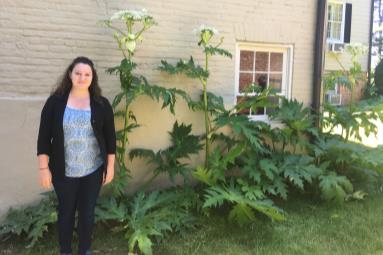 |
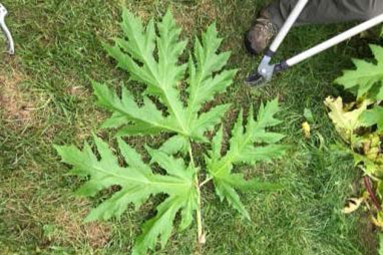 |
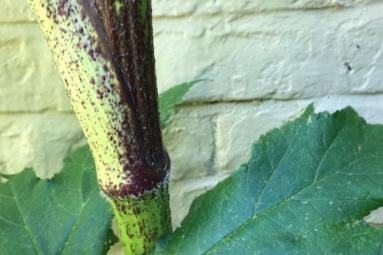 |
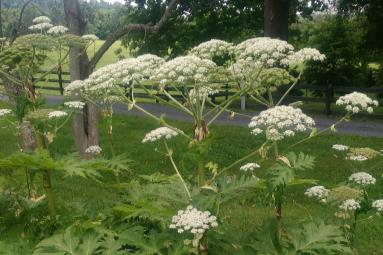 |
| Cow parsnip Heracleum maximum |
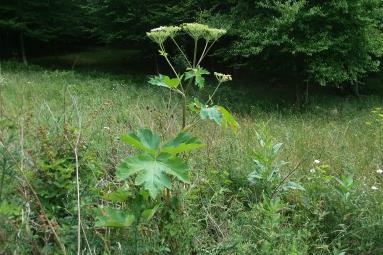 |
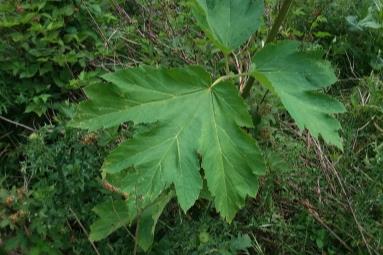 |
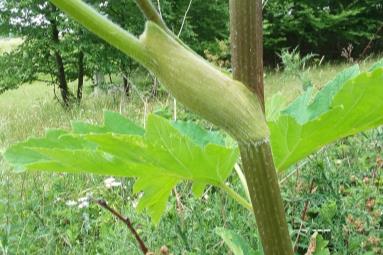 |
 |
| Poison hemlock Conium maculatum |
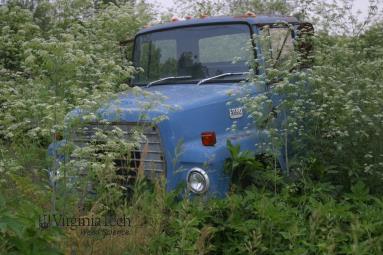 |
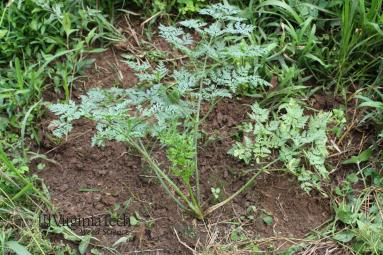 |
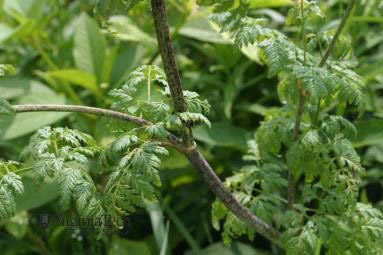 |
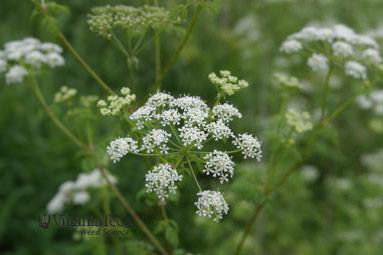 |
| Elderberry Sambucusspp. |
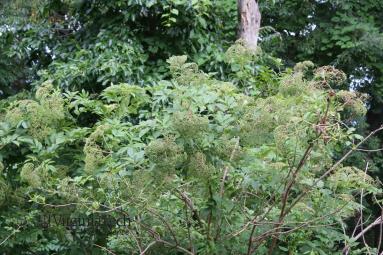 |
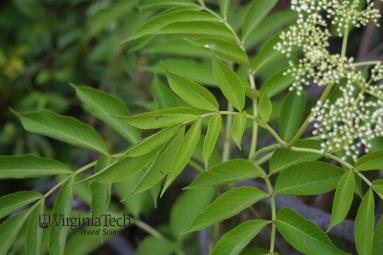 |
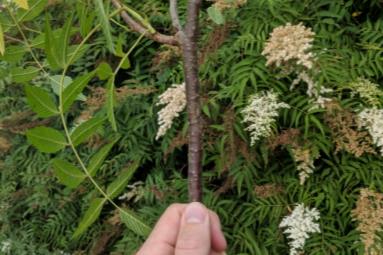 |
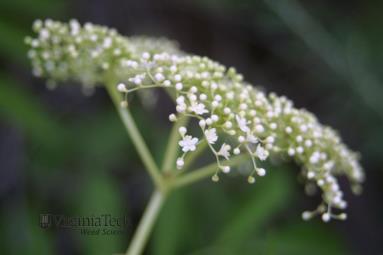 |
Virginia Cooperative Extension materials are available for public use, reprint, or citation without further permission, provided the use includes credit to the author and to Virginia Cooperative Extension, Virginia Tech, and Virginia State University.
Virginia Cooperative Extension is a partnership of Virginia Tech, Virginia State University, the U.S. Department of Agriculture (USDA), and local governments, and is an equal opportunity employer. For the full non-discrimination statement, please visit ext.vt.edu/accessibility.
Publication Date
July 10, 2023



